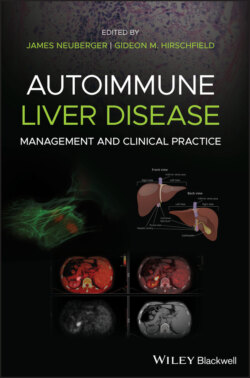Читать книгу Autoimmune Liver Disease - Группа авторов - Страница 25
Basolateral (Sinusoidal) Transporters
ОглавлениеThe uptake of exogenous and endogenous compounds from the portal circulation is facilitated by a number of basolaterally located, sodium‐dependent and sodium‐independent transporters. The sodium‐dependent transporters include the sodium taurocholate cotransporting polypeptide (NTCP), specific to conjugated bile salts and certain sulfated steroids. NTCP accounts for more than 80% of conjugated but less than half of unconjugated bile salt uptake. The sodium‐independent transporters include several members of the superfamily of organic anion‐transporting polypeptides (OATPs). With the exception of OATP2B1, the other OATPs exhibit overlapping transport activities for conjugated and unconjugated bile salts, neutral steroids, steroid sulfates and glucuronides, selected organic cations, and drugs including the antihistamine fexofenadine, opioid peptides, digoxin, the HMG‐CoA reductase inhibitor pravastatin, the angiotensin‐converting enzyme inhibitor enalapril, and the antimetabolite methotrexate. In addition, the basolateral hepatocyte membrane also localizes several ATP‐dependent efflux pumps belonging to the family of MRPs, multispecific transporters for different organic anions. These have been implicated in the cellular efflux of drugs conjugated with glutathione, glucuronic acid, and sulfate (MRP1); the efflux of bile salts (MRP3); and the transport of nucleoside analog drugs (MRP4).
Figure 1.1 Transcriptional regulation of hepatocellular bile formation. Expression of hepatobiliary transporters in hepatocytes determines hepatic bile acid (BA) flux and hepatocellular concentrations of these potentially toxic metabolites. To ensure the balance between synthesis, uptake and excretion, expression of hepatobiliary transporters is tightly regulated by nuclear receptors (NRs). NRs provide a network of negative feedback and positive feed‐forward mechanisms for the control of intracellular concentration of biliary constituents, which are often also ligands for these NRs. BA‐activated FXR is a central player in this network, that represses hepatic BA uptake (NTCP) and (via SHP) synthesis (CYP7A1), promotes bile secretion via induction of canalicular transporters (BSEP, MRP2, ABCG5/8, MDR3), and induces BA elimination via alternative export systems at the hepatic basolateral (sinusoidal) membrane (OSTα/β). Several NR pathways converge at the level of CYP7A1 as the rate‐limiting enzyme in BA synthesis. CAR and PXR facilitate adaptation to increased intracellular BA concentrations by upregulation of alternative hepatic export routes (MRP3 and MRP4) and induction of detoxification enzymes (not shown). Together with RAR, these xenobiotic receptors also regulate the canalicular expression of MRP2. Cholesterol sensor LXR promotes biliary cholesterol excretion via ABCG5/8. Stimulation of AE2 expression by GR stimulates biliary bicarbonate secretion thus reducing bile toxicity. Green arrows indicate stimulatory and red lines suppressive effects on target genes. Bili‐glu, bilirubin glucuronide; BSEP, bile salt export pump; CAR, constitutive androstane receptor; CYP7A1, cholesterol 7α‐hydroxylase; FXR, farnesoid X receptor; GR, glucocorticoid receptor; HNF4, hepatocyte nuclear factor 4; LXR, liver X receptor; MDR3, multidrug resistance protein 3, phospholipid flippase; MRP2, multidrug resistance‐associated protein 2; MRP3, multidrug resistance‐associated protein 3; MRP4, multidrug resistance‐associated protein 4; NTCP, sodium taurocholate cotransporting polypeptide; OSTα/β, organic solute transporter alpha and beta; PC, phosphatidylcholine; PXR, pregnane X receptor; PPARα, peroxisome proliferator‐activated receptor alpha; RAR, retinoic acid receptor; SHP, small heterodimer partner.
Source: Halilbasic et al. [3]. Reproduced with permission of Elsevier.
Hepatocellular transporters are subject to extensive transcriptional and posttranscriptional regulation, allowing for adaptational changes in response to the intracellular accumulation of bile salts. During cholestasis, the NTCP is suppressed through farnesoid X receptor (FXR)‐mediated signaling, thereby preventing the hepatocyte from further accumulating toxic bile salts. Likewise, the expression of OATP1B1 is downregulated. In contrast, cholestasis leads to FXR‐mediated activation of hepatic OATP1B3, which might constitute an escape mechanism promoting the hepatocellular clearance of xenobiotics during cholestasis.
In addition to its role in the uptake of conjugated BAs, NTCP also plays a key role in hepatitis B and hepatitis D virus entry into hepatocytes; and, recently, NTCP has also been shown to modulate hepatitis C virus infection of hepatocytes by regulating innate antiviral immune responses in the liver. As such NTCP has been established as a novel antiviral target.
